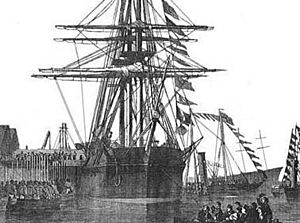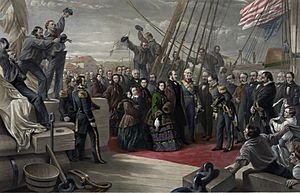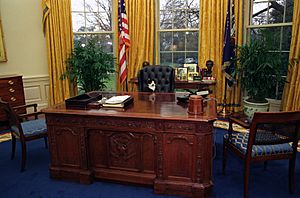HMS Resolute (1850) facts for kids
HMS Resolute was a British Royal Navy ship from the mid-1800s. It was a special sailing ship, built to explore the cold Arctic regions. In 1854, Resolute got stuck in thick ice and its crew had to leave it behind.
However, an American whaling ship later found Resolute floating freely in the ice. The ship was fixed up and given back to Queen Victoria of Britain in 1856 as a gift from the United States. Later, some of the ship's wood was used to make the famous Resolute desk. This desk is now in the White House Oval Office and is used by the President of the United States.
Contents
Exploring the Arctic: The Search for Franklin
In the mid-1800s, people were very worried about Franklin's lost expedition. This was a British group led by Sir John Franklin who had sailed to the Arctic in 1845. They were trying to find the North West Passage, a sea route through the Arctic. But they disappeared!
To find them, the British government sent out many search expeditions. Between 1848 and 1850, they bought six merchant ships and turned them into exploration vessels. Two were steamships, HMS Pioneer and HMS Intrepid. The other four were sailing ships: Resolute, Assistance, Enterprise, and Investigator.
Resolute was originally named Ptarmigan. It was bought in February 1850 and renamed a month later. Workers at the Blackwall Civilian Shipyard prepared it for Arctic travel. They added strong wooden beams, a heating system, and even a polar bear figurehead on the front!
Early Arctic Expeditions
From 1850 to 1851, Resolute (which was the main ship), Assistance, Pioneer, and Intrepid sailed through the eastern Arctic. They were led by Horatio Thomas Austin. This expedition found clues from Franklin's first winter camp on Beechey Island.
During one winter, from October 1850 to March 1851, two officers from the expedition wrote five stories for a newspaper called The Illustrated Arctic News. These stories were about their experiences in the Arctic. When Resolute returned to England, these stories were printed in London.
The Belcher Expedition's Mission
After returning to England, the ships were restocked and put under the command of Sir Edward Belcher. A fifth ship, North Star, joined the group. North Star stayed at Beechey Island as a supply ship.
Belcher's main goals were to find Franklin or any signs of what happened to him. They also needed to search a wider area of the Eastern Canadian Arctic. The plan was to split the expedition at Beechey Island. Resolute and Intrepid would head west. They also needed to deliver supplies to two other ships, Investigator and Enterprise.
The expedition left England in April 1852. They sailed across Baffin Bay in August 1852. After all five ships met at Beechey Island, they split up. Belcher's main ship, Assistance, and its steam tender, Pioneer, went north. Resolute, now led by Captain Henry Kellett, and its steam tender, Intrepid, went west. North Star stayed at Beechey Island.
In 1852, seven Royal Navy ships were searching the Arctic. Only Enterprise found small pieces of wood from Franklin's expedition on the eastern coast of Victoria Island.
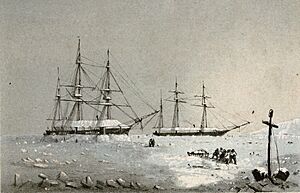
The crew of Resolute set up a winter camp on the ice near Viscount Melville Sound. During the spring and summer of 1853, the crews of Resolute and Intrepid traveled by sled. They searched for clues about Franklin and hoped to find Investigator and Enterprise. They didn't find Franklin or Enterprise. But they did find and rescue Captain McClure and his crew from the ice-bound ship, HMS Investigator, in April 1853.
Captain Kellett ordered McClure to leave Investigator. The ship had been stuck in ice since 1850 because the ice hadn't melted properly. This caused great hardship for the crew, who had to eat less food for over a year.
Before winter arrived, Resolute and Intrepid sailed east. In August 1853, the weather turned cold, and the open water froze, trapping Resolute in the ice. The ice slowly carried Resolute eastward. The crew prepared the ship for winter by storing its sails and upper parts below deck.
Resolute was still stuck in the ice in the spring of 1854. In April, Belcher ordered Captain Kellett to abandon Resolute. Even though Kellett didn't want to, he followed orders and prepared the ship for winter. In May, Captain Kellett left Resolute stuck in the moving ice. He led his men on a difficult march across the ice to reach the other expedition ships at Beechey Island. This group included the crews of Investigator, Intrepid, and Resolute.
Two other main ships from Belcher's fleet, Assistance and Pioneer, were also abandoned. Belcher arrived at Beechey Island between May and August 1854. The men were divided among North Star and two rescue ships, HMS Phoenix and HMS Talbot. These rescue ships arrived just as the crowded North Star was about to leave. The men left Beechey Island on August 29, 1854.
The British government announced that the abandoned ships, including Resolute, still belonged to them. But they didn't try to rescue them.
Resolute is Found and Returned
On September 10, 1855, the abandoned Resolute was found floating in an ice floe. It was discovered by an American whaling ship called George Henry, led by Captain James Buddington. This was off Cape Walsingham, Baffin Island, about 1,200 miles (1,900 km) from where it had been abandoned.
A newspaper article from October 1856 described Captain Buddington and his crew's discovery:
Finally, stealing over the side, they found everything stowed away in proper order for desertion—spars hauled up to one side and bound, boats piled together, and hatches closed. Everything wore the silence of the tomb. Finally reaching the cabin door they broke in, and found their way in the darkness to the table. On it they accidentally turned on a box of lucifer matches; in a moment one was ignited, the glowing light revealed a candle; it was lit and before the astonished gaze of these men exposed a scene that appeared to be rather one of enchantment than reality. Upon a massive table was a metal teapot, glistening as if new, also a large volume of Scott's family Bible, together with glasses and decanters filled with choice liquors. Near by was Captain Kellett's chair, a piece of massive furniture, over which had been thrown, as if to protect this seat from vulgar occupation, the royal flag of Great Britain.
Buddington split his crew and took 13 men with him on Resolute. He arrived home in New London, Connecticut, on Christmas Eve.
Most of the expeditions searching for Franklin were paid for by the British government. However, two expeditions were funded by Henry Grinnell, a New York merchant. The United States government also helped. Senator James Mason of Virginia suggested to Congress that they should pay to fix Resolute and return it to England. This would be a gesture of friendship between the two countries. Grinnell supported this idea. The United States Congress bought Resolute for $40,000.
Once the ship was repaired, Commander Henry J. Hartstene sailed Resolute to England. He presented the ship to Queen Victoria on December 13, 1856, as a symbol of goodwill.
Both Grinnell and Lady Jane Franklin hoped that the restored Resolute would be used for another search for Franklin. However, evidence found by John Rae showed that Franklin's crew had faced terrible conditions and likely died. The British government decided not to send another expedition. Lady Franklin then organized a private expedition. In 1859, this expedition, led by Francis Leopold McClintock, finally found the only written account of Franklin's fate.
Resolute served in the Royal Navy from 1856 but never left British waters. It was retired in 1879 and later taken apart for its wood. The Canadian town of Resolute, Nunavut, is named after the ship. In March 2009, British Prime Minister Gordon Brown gave US President Barack Obama a framed document about Resolute and a pen holder made from the wood of another Royal Navy ship, HMS Gannet.
The Famous Resolute Desks
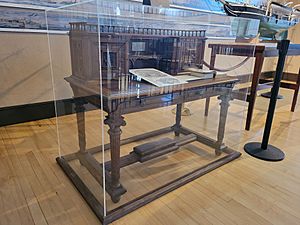
The British government ordered at least three desks to be made from the wood of Resolute. They were built by skilled workers at the Chatham Dockyard.
The President's Desk
A large desk was given to U.S. President Rutherford B. Hayes in 1880. This was a thank-you gift for the United States rescuing and returning Resolute. This desk is known as the Resolute desk. Since then, almost every American President has used it in some way. Eight Presidents have used it as their main desk in the Oval Office, starting with John F. Kennedy. Some Presidents have kept it in their private study in the Executive Residence.
The Grinnell Desk
A second, smaller desk, called the Grinnell Desk or Queen Victoria Desk, was also made from Resolute's wood. This desk was given to the widow of Henry Grinnell in 1880. It was to thank her husband for his generous help in searching for Franklin. In 1983, this desk was given to the New Bedford Whaling Museum in New Bedford, Massachusetts, where it is now on display.
The Royal Collection Desk
A third desk, which is more like a writing table, was made for Queen Victoria. It is still part of the Royal Collection today.
Resolute in Pop Culture
The story of HMS Resolute has appeared in books and movies:
- The 2007 book HMS Resolute by Elizabeth Matthews tells the story of the ship's discovery by the whaler George Henry.
- HMS Resolute's story is an important clue in the movie National Treasure: Book of Secrets. The movie suggests that clues are hidden in the two Resolute desks.
- The book Resolute by Martin Sandler shares the historically accurate story of the different expeditions connected to John Franklin's journey, including HMS Resolute.


